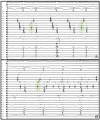Percutaneous Treatment of Non-paroxysmal Atrial Fibrillation: A Paradigm Shift from Pulmonary Vein to Non-pulmonary Vein Trigger Ablation?
- PMID: 30588313
- PMCID: PMC6304790
- DOI: 10.15420/aer.2018.56.2
Percutaneous Treatment of Non-paroxysmal Atrial Fibrillation: A Paradigm Shift from Pulmonary Vein to Non-pulmonary Vein Trigger Ablation?
Abstract
Pulmonary vein antrum isolation is the most effective rhythm control strategy in patients with paroxysmal AF. However, catheter ablation of non-paroxysmal AF has a lower success rate, even when persistent isolation of pulmonary veins (PVs) is achieved. As a result of arrhythmia-related electophysiological and structural changes in the atria, sites other than the PVs can harbour triggers. These non-PV triggers contribute to AF relapse. In this article, we summarise the rationale and current evidence supporting the arrhythmogenic role of non-PV triggers and our ablation approach to patients with non-paroxysmal AF.
Keywords: Atrial fibrillation; catheter ablation; non-pulmonary vein trigger; outcomes.
Conflict of interest statement
Disclosure: Luigi Di Biase is a consultant for Biosense Webster, Boston Scientific, Stereotaxis and St Jude Medical; and has received speaker honoraria from Medtronic, Atricure, EPiEP and Biotronik. Andrea Natale has received speaker honoraria from Boston Scientific, Biosense Webster, St Jude Medical, Biotronik and Medtronic; and is a consultant for Biosense Webster, St Jude Medical and Janssen. All other authors have no conflicts of interest to declare.
Figures



Similar articles
-
Pulmonary Vein Antrum Isolation in Patients With Paroxysmal Atrial Fibrillation: More Than a Decade of Follow-Up.Circ Arrhythm Electrophysiol. 2016 May;9(5):e003660. doi: 10.1161/CIRCEP.115.003660. Circ Arrhythm Electrophysiol. 2016. PMID: 27162030 Clinical Trial.
-
Active or passive pulmonary vein in atrial fibrillation: is pulmonary vein isolation always essential?Heart Rhythm. 2014 Apr;11(4):579-86. doi: 10.1016/j.hrthm.2014.01.009. Epub 2014 Jan 10. Heart Rhythm. 2014. PMID: 24418165
-
Beyond Pulmonary Vein Isolation: the Role of Additional Sites in Catheter Ablation of Atrial Fibrillation.Curr Cardiol Rep. 2017 Aug 9;19(9):86. doi: 10.1007/s11886-017-0884-4. Curr Cardiol Rep. 2017. PMID: 28795289 Review.
-
Catheter Ablation of Paroxysmal Atrial Fibrillation Originating from Non-pulmonary Vein Areas.Arrhythm Electrophysiol Rev. 2018 Dec;7(4):273-281. doi: 10.15420/aer.2018.50.3. Arrhythm Electrophysiol Rev. 2018. PMID: 30588316 Free PMC article. Review.
-
Five-year efficacy of pulmonary vein antrum isolation as a primary ablation strategy for atrial fibrillation: a single-centre cohort study.Europace. 2016 Sep;18(9):1335-42. doi: 10.1093/europace/euv439. Epub 2016 Feb 2. Europace. 2016. PMID: 26838694
Cited by
-
Mapping and Imaging in Non-paroxysmal AF.Arrhythm Electrophysiol Rev. 2019 Jul;8(3):202-209. doi: 10.15420/aer.2019.18.1. Arrhythm Electrophysiol Rev. 2019. PMID: 31463058 Free PMC article. Review.
-
Long-term Outcome of Pulmonary Vein Isolation Versus Amiodarone Therapy in Patients with Coexistent Persistent AF and Congestive Heart Failure.Card Fail Rev. 2020 Apr 9;6:e04. doi: 10.15420/cfr.2019.03. eCollection 2020 Mar. Card Fail Rev. 2020. PMID: 32377383 Free PMC article. Review.
-
Individualised Approaches for Catheter Ablation of AF: Patient Selection and Procedural Endpoints.Arrhythm Electrophysiol Rev. 2019 Jul;8(3):184-190. doi: 10.15420/aer.2019.33.2. Arrhythm Electrophysiol Rev. 2019. PMID: 31463056 Free PMC article. Review.
-
Provocation and ablation of non-pulmonary vein triggers in nonparoxysmal atrial fibrillation: Role of the coronary sinus.HeartRhythm Case Rep. 2020 May 18;6(5):231-236. doi: 10.1016/j.hrcr.2019.10.010. eCollection 2020 May. HeartRhythm Case Rep. 2020. PMID: 32461886 Free PMC article. No abstract available.
-
Intra-atrial activation pattern is useful to localize the areas of non-pulmonary vein triggers of atrial fibrillation.PLoS One. 2022 Apr 25;17(4):e0264894. doi: 10.1371/journal.pone.0264894. eCollection 2022. PLoS One. 2022. PMID: 35468171 Free PMC article.
References
-
- Di Biase L, Mohanty P, Mohanty S et al. Ablation versus amiodarone for treatment of persistent atrial fibrillation in patients with congestive heart failure and an implanted device: results from the AATAC Multicentre Randomised Trial. Circulation. 2016;133:1637–44. doi: 10.1161/CIRCULATIONAHA.115.019406. - DOI - PubMed
Publication types
LinkOut - more resources
Full Text Sources
Research Materials

